Natural Sugar… It’s Good For Us, Right?
The food industry and their marketing army want us to believe that natural sugar is superior.
Surely natural sugar has some nutritional or medicinal value. Doesn’t it?
Well, the short answer is, “Your body doesn’t care if it’s natural sugar.”
When it comes to restoring your health, eliminating cravings, losing weight, fighting cancer and more, choosing the best sweetener for great health becomes…. EASY.
Once you know this ONE SIMPLE TRUTH…. which I cover in the video and article below.
Now you can AVOID being FOOLED by NATURAL Sugar and KNOW the BEST SUGAR for your health.
Watch The Natural Sugar Myth
The Natural Sugar Myth – Transcription
Charlie McDermott: Let’s get into The Natural Sugar Myth. Is there Hidden Sugar Lurking in Shocking Places?
Barb McDermott: It is subtle. Right? We’re up against a lot. Even Pat just sent us a question. That’s why I have my laughing man ready for later, because things come at us right and left along with the things we knew before what we know now to be actually true. It’s not the things we don’t know that gets us into trouble. It’s the things we know that aren’t so. Right?
Charlie McDermott: Yep.
Barb McDermott: It’s subtle, and it’s all about sugar.
Charlie McDermott: And that reminds me of a conversation I just had with an orthodontist.
Barb McDermott: I overheard that conversation.
Charlie McDermott: Actually, he’s part of our program.
Barb McDermott: Cool.
Charlie McDermott: And he was making the point, because he is crazy busy, how freeing this is, once you get through the initial videos as you all know. My goodness, if you’re not eating most of the day because you’re not hungry most of the day, guess what else you’re not doing, preparing meals, shopping as often … All that stuff. It actually frees up a substantial amount of time on a daily and weekly basis. But it morphed into the subtleness of how these very small adjustments create a big positive change… It’s like a major ripple effect.
Barb McDermott: Tonight we are focusing on simple natural sugars. Everything that we at SHIFT Insiders stand for is insulin suppression. Right? Suppressing the amount of that fat storage hormone, that growth hormone, that atherogenic hormone. It is an anabolic hormone that’s all about growth. We want to keep insulin levels down. The only way we can lower insulin is to make sure that our blood sugar stays down. So, understanding all of these foods and how they’re literally all sugar, natural sugar, there’s just no way around it.
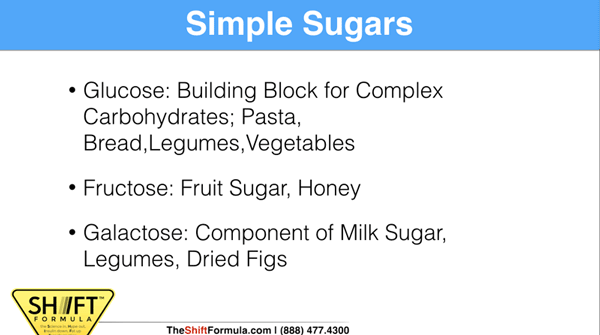
Natural Sugar – The Fructose & Honey Myth
Barb McDermott: The simple natural sugars that come into our carbohydrate world are things like glucose and fructose and galactose. Glucose, you all know that. Right? That’s the building block of every complex carbohydrate out there, pastas, vegetables, beans, breads, all those carbohydrates break down into glucose.
Fructose is the natural sugar in our fruit and our honey. We just watched a documentary on honey bees. That’s probably why it came into our mind, because this man was saying in the documentary, first of all, our agriculture is stealing or stripping the land. And bees don’t have the ability to pollinate because there are less trees and flowers because we’ve made room for wheat and grain.
Barb McDermott: But he was saying how the honey industry today is having a giant boom because there is a savvy or enlightened eater movement, foodies out there who want to eat locally. They want to know the source of their food. And they believe that consuming something like honey trumps consuming cane sugar. It’s less processed, natural sugar. But he made the point that honey consumers don’t necessarily know what they’re doing.
Charlie McDermott: Yeah. He’s the head of the Honey Bee Association or the Honey Industry.
Barb McDermott: He commented in the documentary, “You know, it’s kind of funny because we’re cashing in. And our consumers don’t realize that the body metabolizes sugar and honey the exact same way.” “But hey, it’s great for business!”
Charlie McDermott: The other point was when they looked at the annual production of all the bees worldwide, and the amount of honey that is sold, it is … I forget. It was multiple times more honey sold than what is created or produced. And so the documentary gets in … It’s called Rotten. It’s on Netflix….It gets into how in many cases, we think we’re getting honey, but there are oftentimes fillers added to stretch the product. China’s a big player.
Barb McDermott: Oh, yeah. They try to sneak it in every which way.
Charlie McDermott: Adding fillers into honey. But anyway.
Barb McDermott: However, the final point is that regardless of origin, fillers, organic and pure, or sourced from a foreign country or in our own backyard, it’s still sugar to the body … natural sugar or not.
Charlie McDermott: Yeah.
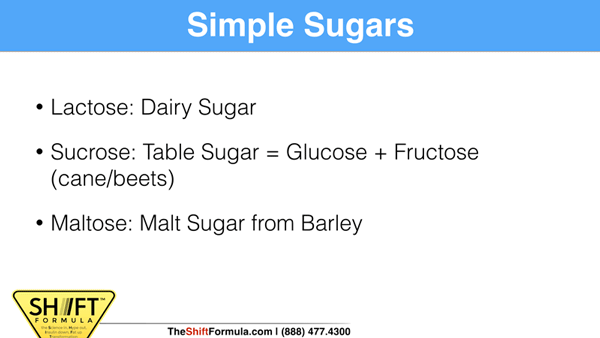
Barb McDermott: Okay? And then of course, galactose is one of those forms of sugar that is a component of milk sugars and beans. I had to put dried figs down there because it reminds us again that dried fruit is concentrated amounts of natural sugar. Right?
Lactose is dairy sugar. Sucrose is table sugar, which is made up of glucose and fructose. And all of these natural sugars are usually in combination with each other, kind of like honey bee hive keepers, for lack of a better word.
They’ll cross pollinate different hives to create a certain flavor profile, a certain kind of honey. Well, in nature, all these different natural sugars work together. Then when we eat and digest, they all break down to glucose, except the fructose. Fructose, a natural sugar found in fruit, goes straight to the liver and generates a triglyceride, whereas all other natural sugars break down to glucose.
Barb McDermott: And this is where we start running into trouble. At least, this is where I ran into trouble. It was when we first started paying close attention to carbohydrates. Dieticians and health-conscious eaters advising me, “Get the blue agave nectar. Get these nutritionally superior natural sugars for your daughter because they are healthier.” And upon using them I’m like, “Still the same amount of insulin dosing happening. Still the same blood sugar rise.” But just take a look. One tablespoon of what is considered a low glycemic sweetener, one tablespoon is 16 net carbohydrates. We know-
Charlie McDermott: And that actually is on the label if you can’t see it. It says, “Low glycemic sweetener.”
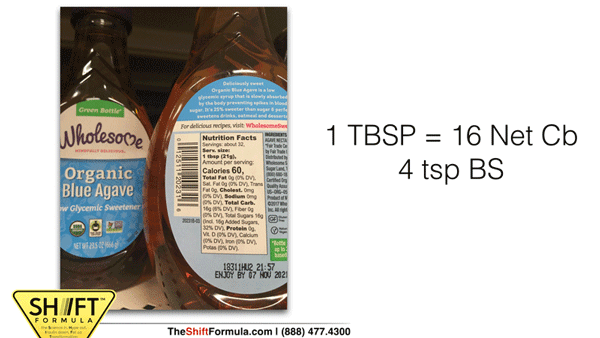
Barb McDermott: Which means it breaks down slower than regular sugar, but it doesn’t impact blood sugar any less. It just happens a little slower. And there’s this seductive thinking, “Oh, if blood sugar rise happens slower, we’re good.” No. The blood sugar surge will just happen 15 minutes later, or maybe an hour later. But the Insulin response will still-
Charlie McDermott: Be the same.
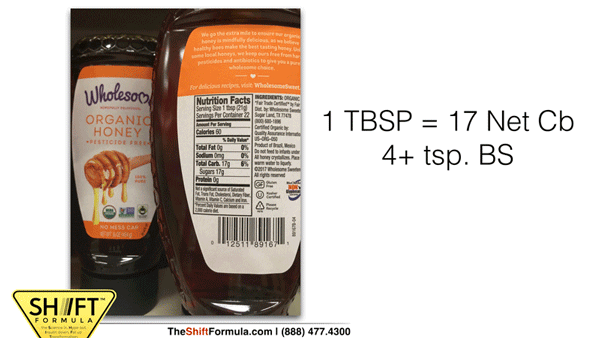
Barb McDermott: Yeah. And I get it. A crazy, quick blood sugar spike can occur, like my 3 year-old son’s energy outburst upon biting off the head of a chocolate bunny on Easter morning, we have that kind of blood sugar surge. But still, immediate or slow, insulin will rise proportional to blood sugar rise, no matter what the speed. And this is where we can understand that organic honey offers no different experience than other natural sugars. In fact, organic honey actually contributes to a slightly higher blood sugar rise. This natural sugar, organic honey is 17 net carbohydrates per one tablespoon, even a bit more than the agave nectar.
Charlie McDermott: There are 16 grams net carbohydrate for agave nectar, and 17 net carbohydrate for the organic honey. Both natural sugars. Okay.
Barb McDermott: Yeah. And then remember, you may see some labels with different nutritional values. For honey, the 17 grams net carbohydrate tends to be the consistent value. But I’ve seen labels read as low as 12. There is a built in 20% margin of error for nutritional labeling. A food product company is going to use that margin of error to their advantage and make their product look as appealing to you and me as legally possible.
Charlie McDermott: And just to break it down even further for those who are new, 17 net carbs is equivalent to over four teaspoons of blood sugar. Consuming any form of sugar, processed or natural sugar generates blood sugar.
Where Does The Blood Sugar Go?
Barb McDermott: Blood sugar, blood sugar, yeah. When the body metabolizes those 17 grams of carbohydrate from the honey, we’re going to have an instant, pretty damn instant, four teaspoons of blood sugar rise. Yeah. One tablespoon of honey, four teaspoons of blood sugar. In the kitchen, one tablespoon is equivalent to three teaspoons, if you really want to measure things out.
Charlie McDermott: Yeah. That’s interesting. Yeah.
Barb McDermott: Good grief. Right? Okay. Here we go. Here’s a bag of sugar. This is natural sugar. I was at Target this weekend, that’s where I was taking these pictures. Now the interesting thing is this bag of sugar uses teaspoons not tablespoons for their serving size.
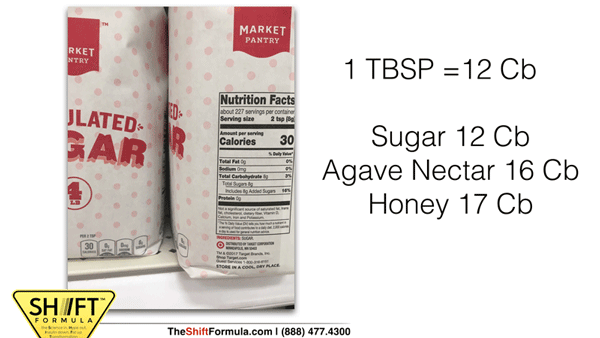
Barb McDermott: They label the serving size by teaspoons. So, you must stop and do your math. The label reads two teaspoons of sugar is eight carbohydrate. Since we’re comparing sugar options by tablespoons, we have to add another teaspoon to the sugar value. Three teaspoons is one tablespoon, so this bag of sugar is 12 net carbohydrate per tablespoon. But look at the difference. The sugar actually is less net carbohydrate than these other seemingly superior natural sugars.
Charlie McDermott: So we have, again, for those who can’t see it.
Barb McDermott: One tablespoon of table sugar is 12 net carbohydrates. Agave nectar, a natural sugar, is 16 net carbohydrates. Honey, also a natural sugar, is even higher at 17 net carbohydrates. Right? This doesn’t mean any of these are good or bad. We understand if we prefer to use honey, use honey. But know the carbohydrate/blood sugar/insulin toll. Remember the world looks at food nutritionally. We view it metabolically.
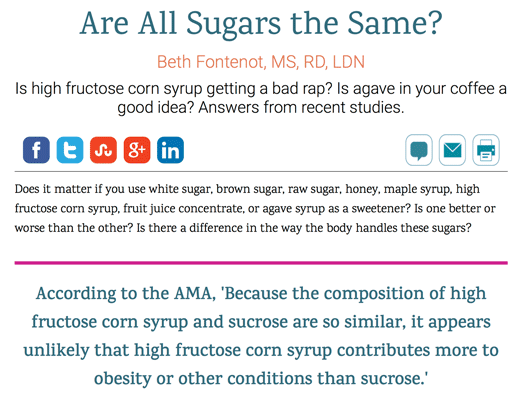
Are All Sugars The Same?
Barb McDermott: Here’s a great article. I did some trolling for you today. Are all sugars the same? It really came down to the answers in science lab, yeah, they’re all the same. And that’s where we operate, in a science lab. Is high fructose corn syrup getting a bad rap? It is a highly processed sugar not a natural sugar. Most of us would agree it’s a food we are wise to avoid.
Barb McDermott: I’ve heard three people just in the past week say, “Sugar’s the devil. Sugar’s evil!” In my mind, sugar’s fine. Sugar comes from a plant. It is sugar. Right? And we know it’s for treats. We know it’s for sweets.
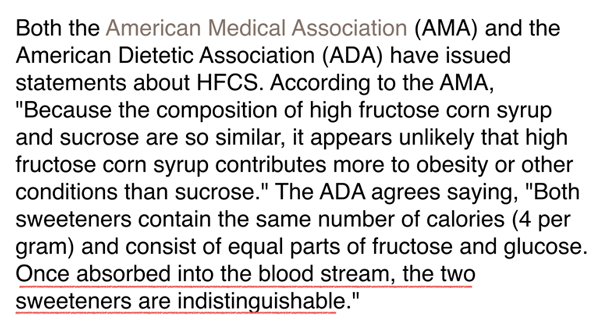
It’s the other foods that are like wolves in sheep’s clothing. Other natural sugars seem to get away without blame, as if they are somehow ‘free’ foods. They’re really the same thing. The article reads, “Is there any difference the way the body handles these sugars, high fructose corn syrup, fruit juice concentrate, agave syrup?” Which one? Is any one better than the others?
Well, according to the American Medical Association, AMA, because the composition of high fructose corn syrup and sucrose, that’s table sugar, are so similar, it appears unlikely that high fructose corn syrup contributes more to obesity or other conditions than sucrose.”
Barb McDermott: But here’s the thing. High fructose corn syrup is really cheap, it’s produced from corn, a grain. And it’s put into bread. It’s put into condiments. It’s put into everything that you’re buying your children because it’s really addictive. Right?
The food industry doesn’t necessarily care about our health. It cares about profit. Because high fructose corn syrup is usually in all those packaged “junk food” products that’s why we say it’s ‘the devil’. But that ingredient, it’s no worse or better than any natural sugar. If you go down to the very last sentence, or right above it, it says, “Even the American Dietetic Association agrees with the American Medical Association.” Both sweeteners contain the same number of calories, energy, four per gram.
Charlie McDermott: And those sweeteners are?
Barb McDermott: High fructose corn syrup and sucrose. They consist of equal parts of fructose and glucose. No matter what form it is, processed or natural sugar, once it’s absorbed into our blood stream, the two sweeteners are indistinguishable.
The body can’t tell them apart. Right? The body is not prejudiced.
Organic Natural Sweeteners Impact Us The Same Way As Processed Sweeteners
And this is where we get upset, for you and for others out in the world, who are following rules like, “oh, I’m just supposed to have honey instead of sugar, and I’ll be fine”. And then we realize, no, honey is just the same thing as sugar.
This is a response to that article.
Charlie McDermott: You want to read this?
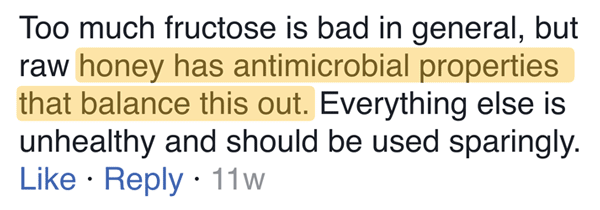
Barb McDermott: Yes. Someone responded to that article we just finished, “Too much fructose is bad in general. But raw honey has antimicrobial properties that balance this out.” Some people say, ‘medicinal’ properties. Does honey have some nutritional merit? Yeah, it does. Does it balance out the metabolic toll that the sugar will put into our body? Absolutely not. No nutritional value can in any way take away from the metabolic burden that it puts on your body. But no one replied to this person who wrote this. And this is what many believe is true. That’s what I once thought.

Barb McDermott: The source of the sugar, processed or organic natural sugar, has no influence on how our body metabolizes it. That’s why I call it the organic panic. Eating organic foods over non-organic foods is a great idea for avoiding harmful additives.
But Just Because Something Is Organic Doesn’t Mean It Is Impact-Free. It still generates blood sugar. It Still Stimulates Insulin.
And remember, our blood sugar is glucose. And our insulin and glucose together are the two variables that support cancer. They’re the two variables that start driving Alzheimer’s plaque. They’re the two variables that influence the hardening of our arteries and the worry of heart disease. That’s diabetes in a nutshell.
Diabetes is only a symptom, though. Right? It’s not about high blood sugar. It’s about how much insulin our body has to produce to maintain, or manage, or chase after that blood sugar.
Barb McDermott: So then as I was trolling today, I found this. I thought, “This is a good thing for us to put up.” It’s a lot to look at. But turn your attention to this chart. This was in the Huffington Post. We have come from a world that has said fruit is “it”. It’s your best friend. Actually, even, they have a little thing down the bottom right. “Important note, eating fruit is better than eating none at all”. I’m like, Hmmm…. “Well, okay. That’s a little vague.” But I see that, Mary, thanks for your comment. Yes. Many people think that the fiber in fruit is quite powerful, that there’s so much fiber in the fruit that the sugar component is canceled out. Right?
Charlie McDermott: Mm-hmm (affirmative).
Barb McDermott: And those of you who are already a SHIFT Insider, you see this. Right? As the fruits go north or vertical, they contain more fructose. As you can see, grapes contain the highest amount of fructose. And if you look along the bottom, there’s cucumber, broccoli’s down there, green beans, peas and parsnips and avocado, and brussels sprouts. But that’s north to south. But from east to west or left to right, that shows the fiber content. Now we’re trying to zero in on which ones are the furthest south or the least amount of fructose and sugar, and are as far over to the right with highest fiber content. You see, avocado lands in a place of honor. Right?
Charlie McDermott: Yeah.
Barb McDermott: And raspberries. Blackberries and raspberries. And even the middle section with the blueberries and the pomegranate, the apple falls there, along with the fig. They’re all in that middle place. We don’t heavily reach for those. We understand that we use those strategically. But again, the world thinks that the fiber cancels out the sugar content, and it doesn’t. You can subtract it out of total impacting carbohydrate because the fiber does go right through us, and the fiber is a part of the carbohydrate content. But it doesn’t cancel out its blood sugar impact.
Are Complex Carbohydrates Better Than Simple Carbohydrates?
Barb McDermott: Both simple and complex carbohydrate break down into glucose. Carbohydrates are either in a simple straight chain of glucose or a branched chain of glucose. Either form is comprised of glucose. The point is that they all break down to glucose.
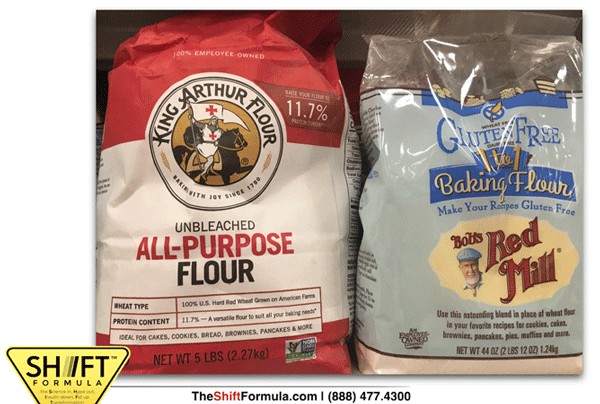
Barb McDermott: Here’s a perfect example of a kind of food that breaks down quite rapidly into glucose or blood sugar. On the left King Arthur Flour, unbleached all-purpose flour, which is what used to be in my cabinet all the time. And on the right is a gluten free version of baking flour, for those of us who are diagnosed with celiac, or have some kind of situation where we know gluten is not working for us.
But just like a person opting for honey instead of regular sugar is really just making a lateral move, and even a slightly backward move, because it’s actually more blood sugar impacting glucose. Same thing happens with conventional flour as compared to gluten-free flour.
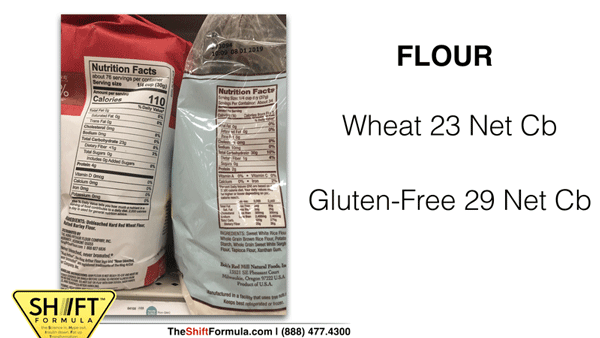
Barb McDermott: Let’s take a look. The picture on the left is the conventional flour in the red package. And on the right side is the gluten free flour in the blue package. The interesting thing is that those of us having to go the celiac way end up with more compromising net carbohydrate in the gluten free flour than in the traditional wheat flour. It’s not much more. But it adds up in recipes and over time. Again, we think we’re talking about lateral moves. They’re not lateral. They are alternatives that often end up compromising or moving us backwards a bit.
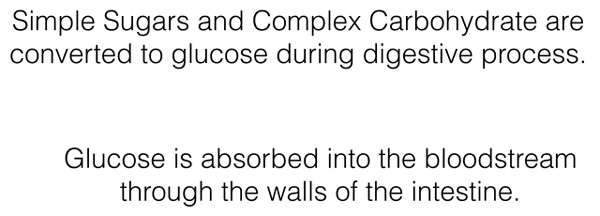
Barb McDermott: Both simple sugars or simple carbohydrates and complex carbohydrate are converted to glucose during the digestive process. Once it’s all broken down, the glucose enters our bloodstream through the intestine.
Take a look at this grocery shopping list that was sent to me.
The sender said, “Hey. Check this suggested shopping list. It’s recommended nutrition for women eating to beat breast cancer.” The underlying message is to choose unprocessed foods over processed. A good concept. But the outcome may not create the desired health gain they are in pursuit of.
Barb McDermott: And this is where we can understand dieticians and nutritionists laying out the directives they learned in school. They haven’t really had to apply the science to an actual body. Right? Can everyone here back me up on this? Do you see what I see? Is this entire page what I think it is? Carbohydrate? Right?
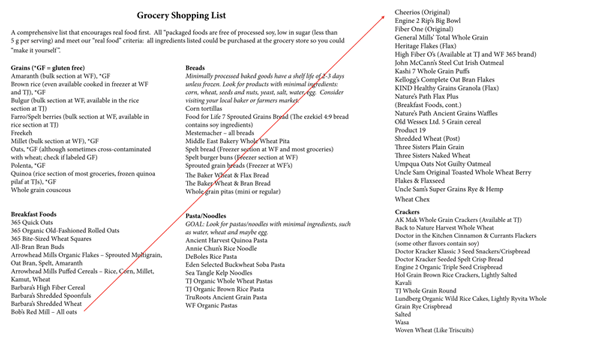
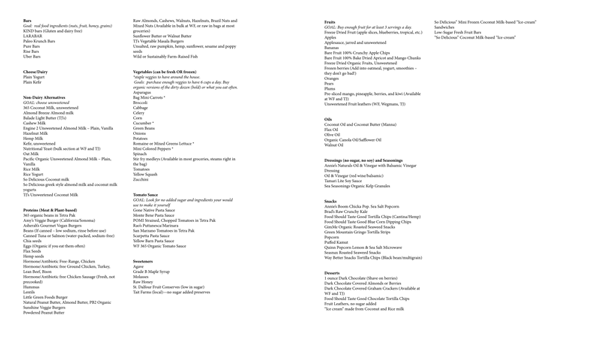
CharlieMcDermott: Let me just go through the breakfast foods.
Barb McDermott: Yeah. Go ahead.
Charlie McDermott: We have 365 quick oats, 365 organic old-fashioned rolled oats, 365 bite sized wheat squares, all-bran bran buns.
Barb McDermott: Buns.
Charlie McDermott: Organic flakes, oat bran, amaranth, arrow head mills puffed cereals, rice corn millet. I can’t pronounce half these words.
Barb McDermott: That’s okay.
Charlie McDermott: High-fiber cereal, shredded wheat…
Barb McDermott: Cereal, cereal, cereal, cereal, cereal.
Charlie McDermott: All oats, Cheerios, Engine 2 RIPs. Is that R-I-P? as in “rest in peace”?
Barb McDermott: I don’t even know.
Charlie McDermott: Fiber One.
Barb McDermott: They’re different brands.
Charlie McDermott: Total. I was having fun with rest in peace. Keep eating this and you’ll be dead. High fiber Os. Steel cut Irish oatmeal, Kashi seven grain whole puffs, Kellogg’s complete oat bran, Kind healthy grain granola, Nature’s Path flax plus, Nature’s Path Ancient Grain Waffles. We have grain cereal. I have Product 19. We have shredded wheat. We have Three Sisters Plain Grain. We have Three Sisters Naked Wheat.
Barb McDermott: Those Three Sisters get around.
Charlie McDermott: Yeah. Yeah. And four or five others.
Barb McDermott: And here’s where the trial comes in because that’s where we were.
Charlie McDermott: Where are the eggs?
Barb McDermott: On the next page. But I want to start here because we know to look through the lens of foods metabolically. How does the food impact the body? What does it convert to? What does it change to within my body?
Eating To Defeat Breast Cancer? Here’s What You’re Really Eating
When I Look At This List, I See Cancer Cell Fuel.
That’s what I see. Certainly, blood sugar, but blood sugar is cancer cell fuel. Right? And there are books out there in the world, like Eating Pretty books, which are lovely ideas of, let’s take food and understand the nutritional value.
But then you see things like eating a lot of lentils because it’s a protein powerhouse. And ‘it has blood sugar stabilizing energy’. How do lentils stabilize blood sugar? ‘Millet is a seed of happiness that also maintains blood sugar’. Again, anyone, right? ‘Quinoa, low glycemic index, steadies your blood sugar’.
The Lie Of “Eat This To Stabilize Blood Sugar”
It’s just not true. None of this is true. None of this stabilizes blood sugar. All of this is blood sugar.
Charlie McDermott: The maddening part of this that somewhat drives anger, is that this is the norm.
Barb McDermott: This is the norm.
Charlie McDermott: And there are people who are-
Barb McDermott: Running around trying to buy these things……
Charlie McDermott: Well, and banking their lives on the validity of this, and reading books like this, hoping that this is their answer, whether they’re fighting cancer or trying to survive it. It’s maddening and hurtful.
Barb McDermott: Yeah. It is maddening. And it’s frightening. Yeah. Karen Tinder just shared, “Every single one of those foods would inflame my joints.” Alana just shared that “every single one of those would just send her blood sugar skyrocketing”. She knows because she’s Type One. But the rest of us don’t know, and that’s the seductive dance. And then it goes onto this. Here’s the rest of the foods that cancer compromised individuals are encouraged to eat. And here’s the thing, instead of looking at all of it, and not saying, “This is bad or good,” what I see is what I don’t see. Because I said to Charlie, “Everything I ate today, it’s not even on this list at all.”
Barb McDermott: Now there are eggs, I think in the protein section. It does say “eggs, buy organic if you eat them often”. There is a subtle insinuation that maybe you shouldn’t be eating those so often. I felt, after reading this Pretty Eating book, I thought, “Oh, my gosh. I must be the ugliest eater on the planet.” I am not pretty at all. When you see the protein on the chart here, it says meat and plant based protein. But do you see what I see? Almost every protein except for maybe two is actually carbohydrate with a little bit of protein.
Charlie McDermott: Give us an example or two.
[Case Study] Which Foods Raise Blood Sugar
Barb McDermott: Well, we have organic beans. We have veggie burgers, vegan burgers, beans, chia seed, flaxseed. These are all good things. They’re all great. Lentils, hummus.
Charlie McDermott: When you say great, in what way?
Barb McDermott: Well, flaxseed, hemp seed, chia seeds, they’re very good, nutritionally. They’re not going to impact blood sugar. But they’re also not going to fill you up. You’re also taking in far more blood sugar rising carbohydrate than protein. Blood sugar fuels cancer cells.
Charlie McDermott: And when we’re eating that, again, to avoid, to survive, to heal from cancer, that’s the frustrating part of all this.
Barb McDermott: And as far as the cheese and the dairy section, there’s only plain yogurt and plain kefir listed. And then there is a category of “bars’. Kind bars, Lara bars, all those are to me, carbohydrate/blood sugar bars. But, they’re made with real food ingredients, nuts, fruits, honey and grain. Right? When it comes to the fruit section, the directive is to buy enough fruit for at least three servings a day, at least three servings of fruit a day. That’s blood sugar rise. You know, cancer cells are exquisitely sensitive to insulin. They have far more insulin receptors with a heightened sensitivity than our healthy cells. They’re engineered to be able to take advantage of blood sugar surges. The cancer cells are like, “I’ll take that. Thank you.”
Barb McDermott: Nutritional directives like this mislead the very population it’s trying to support and actually creates a situation for cancer cells to take advantage of. These nutritional directives support the actual cancer cells over the person fighting the cancer. When it comes to the oils, there’s no mention of butter anywhere. There’s no butter. There’s certainly no bacon. To some, the idea of eating bacon to beat breast cancer is about has foreign and offensive as can be. And of course, in the sweeteners section, as you can see recommended are agave, maple syrup, molasses, raw honey, and then a few other products there. Yeah.
And then there are the snacks.
Charlie McDermott: Say it.
Barb McDermott: I know. Popcorn. And that’s another thing I’d read in this fun book. Popcorn is hailed as the holy grail of snacking because it’s so low calorie. But it doesn’t even take into consideration that it’s a grain and it’s a blood sugar surge. It doesn’t mean we can’t have popcorn. But don’t mislead people that popcorn is some kind of free food.
Charlie McDermott: Right.
Barb McDermott: Okay. Should we move on? The pasta noodles are a pretty big deal, too … Because when we are led to believe that if you just choose organic ancient grain pasta, you’re good to go. Look for pastas and noodles with minimal-
Charlie McDermott: Especially if you’re paying extra for it, my goodness.
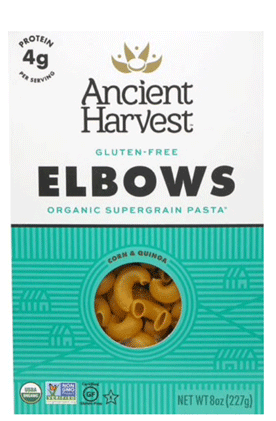
Barb McDermott: Especially if you’re paying a lot extra for it. I pulled out one that was on the sheet. And I thought, “Let’s look it up. Let’s see what this is about.” Ancient Harvest is a brand name. And they’re making elbow macaroni out of the organic super grain, quinoa and corn. You see the corn is the first one written. And I’m not sure if that’s alphabetical, but usually you put the biggest ingredient, the highest ingredient first. They’re telling us it’s all about the quinoa, but I think it’s a lot about the corn. And you all know inside, whenever they put the nutritional thing, they tell you everything but the carbohydrate.
Charlie McDermott: And look at the upper left.
Barb McDermott: yes.
Charlie McDermott: Protein.
Barb McDermott: Protein, four grams per serving. How much protein do we need a day? A lot more than four. I’m going to get, yeah, they make it sound as if it’s high protein. And of course, it’s gluten free. And we’ll give them props for that.
Charlie McDermott: Stephanie says, “I used to buy that by the case load just two years ago.”
Barb McDermott: Yeah. And us too.
Charlie McDermott: And Susan says, “My hospital serves margarine as they are heart healthy.”
Barb McDermott: And, I think it was Doug who shared with us that margarine’s made out of plastic. I mean, cut to the chase kind of a thing. Right? Yeah. It’s very backward and scary out there. Churches and hospitals are the places we really have to be most careful in.
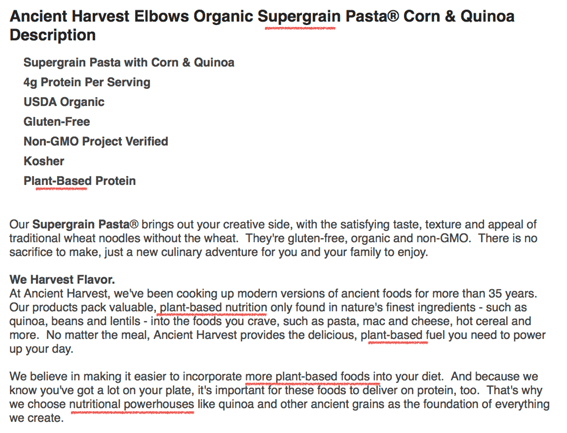
Okay. Here we go. This is where, when you’re a marketing person, you’re asking: What are the words that are reaching out to our demographic? Ancient Harvest, I’ll tell you this. I asked, “Okay. Is there really such a thing as something that’s nutritionally so powerful because it’s ancient? It’s an ancient kind of food. People ate this in ancient times.” Now it’s even better for us? There’s nothing. There’s no correlation. We can throw that one out. Have you ever been offered a meal or food with a, “We’re serving an Ancient Harvest grain salad. It’s the ultimate super food!” Or, “We’re going out for gluten-free pizza! You want to come?” Thanks, but I don’t think I do.
Barb McDermott: But anyway, take a look at this. We see the words, ‘plant-based’, over and over and over. They’re going to help us be a nutritional powerhouse because we’re going to eat more plant-based. Now you and me, we, in SHIFT community, we eat plants. But we don’t go around telling people, pistol shooting, that we are plant-based eaters because we know what? That it is a carbohydrate-based way of eating. And plants are good. But that doesn’t mean everything I eat has to be a plant, because then I don’t even get that full spectrum of protein. The crazy thing is this, and I say this very gently, because we ate vegetarian for a bunch of years, but to eat an animal we are consuming fat and protein. What are we made out of? Fat and protein.
Watch – How Carbohydrates Raise Blood Sugar
Barb McDermott: To think that we can minimize blood sugar surges while feeding exclusively on plants, which is all carbohydrate with very little fat and protein is challenging. Yes, we can get fat from coconut oil and olive oil, but protein from plants always comes with heavy amounts of the darn carbohydrate, blood sugar. And yes, we were talking about: How much protein do we need? You need whatever your ideal body weight is, and cut that in half. That’s about the amount of protein that you need.
Charlie McDermott: Ideal body weight as in not what your current body weight is, but where you should be based on your height.
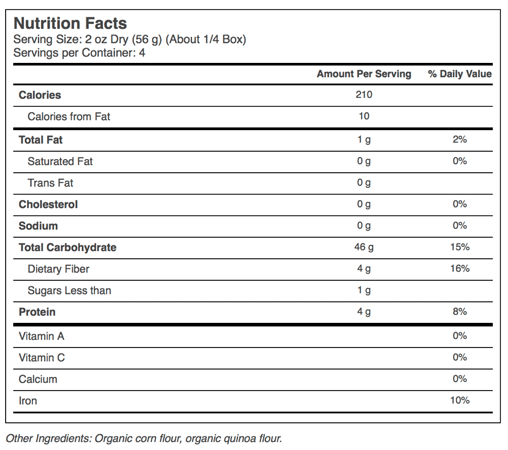
Barb McDermott: The nutrition facts for the elbow macaroni, that is the Ancient Harvest grain, is this. The fat is nonexistent. The protein, really people, that’s nonexistent. The four grams hardly counts for anything.
But the carbohydrate load is 46! Take out the fiber and it’s 42 net carbohydrates. And for those of us who understand how to figure it all out, that’s about 11 teaspoons of blood sugar. “Yikes,”
Now here’s the kicker. You ready for this? If I was going to have some elbow macaroni……I’m holding up my own bowl from my kitchen…..this would be a modest amount for me.
Charlie McDermott: That’s like a soup bowl.
Barb McDermott: It’s like a soup … Well, I guess it’s like a soup, salad bowl.
Charlie McDermott: A large-
Barb McDermott: But compared to my head, to see it on the screen is hard to judge. That’s not the serving size, everybody.
Charlie McDermott: That’s what you would think was the serving size.
Barb McDermott: That’s what you would think, at least.
Charlie McDermott: I was going to say, more like a big plate.
Barb McDermott: This amount would be my starting amount. And I would have piled the macaroni up. But, the serving size is only this little bit, a cup, two ounces of dry elbow macaroni is just this little cup.
Charlie McDermott: But it’s ancient harvest grain macaroni!
Barb McDermott: Yes, this ancient grain generates 11 teaspoons of cancer-feeding blood sugar, and we’d only get to eat this much. That’s outrage!
Charlie McDermott: Which, of course, never happens.
Barb McDermott: Yes. It’s pretty lousy. We always eat more than a packaging’s serving size.
Charlie McDermott: Of course, now you’ve got to keep in mind that it’s organic corn flour and organic quinoa, which I personally would probably only eat that much because that’s all I could take, but which goes back to the fact that a lot of people eat these foods thinking that it’s going to provide some form of super nutrition or super protective power.
Barb McDermott: The thinking becomes, “If it’s good I should eat more of it. I’m going to have three servings….at least!”
Charlie McDermott: Well, it’s not only more of it, but it’s also, they suffer through eating it even if they don’t like it. They would rather eat the other version, which there you go.
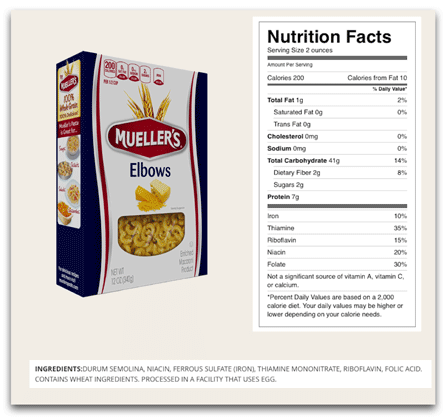
Barb McDermott: Yes, there’s good old Mueller’s. Did I say that right? I’m not even sure. But the elbow macaroni that’s on every shelf everywhere actually has less carbohydrate than the organic ancient grain version per the same amount of serving and…..more protein! Now is it enriched? Perhaps. Many foods are enriched. Right? Virtually every cereal is enriched.
Now I’m going to keep moving forward. I went internet trolling to find ideas and examples for this natural sugar presentation……..
Barb McDermott: And I came upon a pro-pasta dietician woman. She was showing how you make pasta part of your healthy diet. She writes, “My husband and I are pasta people. It’s on our meal plan each and every week, not just because it’s an easy dinner, but also because we constantly crave it.” Duh. Right?
Charlie McDermott: Yeah.

Barb McDermott: “As a dietician, I’ve learned that I can make pasta a healthy, frequent meal if I watch the, beep, beep, beep, beep, portion size.”
Charlie McDermott: What a way to live.
Barb McDermott: And Karen says, “Then you go hungry.” Yes. You do go hungry. Right? But this is what dieticians do to us. You can eat this, but only this much.
Charlie McDermott: Just have a teeny little cup of it.
Barb McDermott: Wait, you had 17 of these? Just 17 individual macaroni noodles!? Are you kidding me? Good grief.
Charlie McDermott: And still be hungry after.
Barb McDermott: And still be hungry.
Charlie McDermott: Two hours later.
Barb McDermott: Yes. Hungry we will be. And right, Karen, thank you for saying that. We would still be hungry because it doesn’t fulfill our energy requirements. Carbohydrate is used up like a finger snap.
And many of us had carried or are carrying carbohydrate as fat, and we can’t access it because we’re eating more carbohydrate. Carbohydrate is blood sugar. Blood sugar drives insulin release. Our insulin levels are up. Our fat stores are locked down.
So we’re always flippin’ hungry. Luann shares, “Five elbows won’t keep me fed.” LOL! Like many dieticians, this one is telling you that you can make it a healthy, frequent meal. How does she define healthy? The fact that she “constantly craves it” tells us a lot.
Charlie McDermott: Frequent as in every two hours because that’s how often I’d be hungry.
Barb McDermott: The little portion of noodles is 200 calories. Whatever, right? We don’t concern ourselves with calories, however the dietician will inform us that to balance out those 200 calories, you could either swim for 17 minutes, jog for 23 minutes, cycle for 27, or walk for 52. Do you see why we’ve been insane? And the math of calories doesn’t work out because the math of calories is actually something that’s determined in a science lab not inside the human body.
Barb McDermott: In our bodies, all those carbohydrate calories end up around our midsection. Not required to meet current energy demands, it was converted to a storage form of energy that we can carry. No one carries glucose. It either gets converted to glycogen, if our muscles and our liver glycogen stores need replenishing, or our body converts glucose to fat because we can carry it and use it later. But then it gets locked down because we’re always eating the frequent darn carbohydrate meal that dieticians are telling us to eat.
Watch – Belly Fat: The Real Cause
Charlie McDermott: The little teeny pasta meal.
Barb McDermott: Yeah, that little teeny pasta meal costs us 11 teaspoons of blood sugar and a proportionate insulin rise. Talk about an insulin surge! And that’s what the world is slowly finding out. You SHIFTers are out in front of the wave, and you know it. Weight is not caloric. It is hormonal. It’s insulin. I know it is insane……..Dawn just shared, “Why do you think the dieticians don’t learn these truths?” Well, some of them are, but not many.
Charlie McDermott: They’re invested in their education. And it’s human nature. I talk about doctors, and they’re so busy and all that. And we get that. But hey, let’s face it, whether you’re a doctor or dietician, a nutritionist, an orthodontist, like the conversation I had earlier today, we’re all busy people. And think about it. After you’ve invested those tens of thousands, maybe hundreds of thousands of dollars in an education, and the system is, by the way, set up because continuing education credits like you go through for the fitness industry.
Barb McDermott: They’re still saying the same thing.
Charlie McDermott: It’s much easier just to go with status quo than it is to roll your sleeves up, dig in, and go, “Hey. Something’s going on here.”
Barb McDermott: Something’s not right.
Charlie McDermott: Let’s dig down and maybe change the textbooks. And for the dieticians, it’s a busy world. So after they’re finished with their clients at the end of the day, they’re exhausted. They go home. They make their little pasta meals, put their kids to bed, and do it all over again. It’s going to take time.
Barb McDermott: And the medical community too, I know that they actually have a book of prescribed answers, or protocol, for any medical-health situation. And it’s backed by their federation. So, to step out and say, “I’m not going to say what the federation’s saying,” you’ve got to be a little bad-ass about it.
Charlie McDermott: And you’ve had that conversation with one doctor in particular.
Barb McDermott: He’s nodding his head yes, but saying, “I can’t say yes.”
Charlie McDermott: The hospital would never back him. And he would never dare cross that line because he’d be annihilated.
Barb McDermott: It really comes down to being self-reliant. We all have to find out for ourselves. We saw it in our daughter. Every expert and directive said, “This (eating natural sugars and organic foods) works.” But, no. Actually, the misleading directives send us backwards. As Ilana had just shared, “The doctors would just say, “Dose more insulin.” No, never. Live in such a way that you need less insulin.
Charlie McDermott: Jeff shares, “I’ve had home nurses who said they would lose their job for not towing the line.” That was basically the conversation that Barb had. Yeah. They’ve got to stick with whatever’s written, and rightly so. You can’t have freewheeling doctors out there. We certainly get that. But my goodness, I think the time has come.
Barb McDermott: And it takes so much education. Look at us in here. How many of us sigh, “I’m drifting”? Or, “Wait, am I really allowed to have butter?” Right, Diane?
And then it takes someone saying, “Yes, I’ve done it for six years. You’re good.” But who’s going to take the time to really go into it? Because it’s easy to say, “Oh, just pull back on the carbs a little bit.” But then the cravings go crazy. And you’re never satisfied. And you never last, so you start eating all those carbohydrates again. You don’t realize, “Wow, if I displace the carbohydrates with some flavorful fat, I win.” Yeah. We win.
Barb McDermott: Really what it comes down to is this. We are not anti-plants-based. We just don’t make an announcement of it. We don’t hang a banner over our heads.
Generally, anyone saying, “Well, just eat plant-based,” is really speaking from a fear-based platform.
They use the plants-based directive as a self-protective measure. They can hide their lack of real knowledge behind the plants-based widely accepted directive.
But you know better.
The plants-based diet is a carbohydrate-based diet. It’s a glucose-based diet because carbohydrate, all of it, breaks down to glucose.
Glucose is blood sugar, so a plants-based diet is a blood sugar diet. A blood sugar diet is what? Fat storing, AGE generating, cancer supporting, insulin stimulating diet.
“Where There’s Carbohydrate, There’s Cravings.”
Barb McDermott: And as we all know, where there’s carbohydrate, there’s cravings. So, a plant- based diet can keep people spinning in insanity. It’s just not fair.
And this last piece in the Eating Pretty book, it talks about ‘eat pretty sweeteners’. It reads, “There are sweeteners that make you pretty. And there are sweeteners that don’t.” “Maple syrup, raw honey, coconut sugar, black strap molasses instead of refined sugar……because it prevents the high insulin spike of refined white sugar.” The author is saying that you’re going to be prettier eating maple syrup or raw honey than eating regular sugar because it’s not going to impact your blood sugar the same way.
But it is. And it does every time.
And young girls read these kinds of books and follow the directives. These misleading directives play on human weaknesses, like the desire to be pretty and to eat ethically or consciously.
These Misleading Directives Play On Human Weaknesses, Like The Desire To Be Pretty And To Eat Ethically Or Consciously.
It all comes down to this.
Sugar Is Sugar
Natural sugar and processed sugar impact blood sugar the same. Organic has no influence on glucose content of any natural or unnatural food. Organic and real foods are not necessarily impact-free or better than other kinds of foods.
Less insulin. Less insulin. Less insulin.
Resources Mentioned & More That Will Help You Regain Health & Vitality… Pleasantly
1.) This Episode’s Free Resource – Download Here
2.) FREE TRAINING: Learn The Secret To Eating DELICIOUS Carbs That Trigger Weight Loss & Lower Blood Sugar.
Learn how the weight loss and food industries have been misleading us for decades. After this training you’ll KNOW how to avoid being fooled again and how to finally get results by replacing diet and deprivation with DELICIOUS.
Register Here:
https://shift.kartra.com/page/n5x574
3.) WEIGHT LOSS SAUCE… Get our 3 Special Sauce Secrets for Weight Loss:
This Episode's FREE Resource
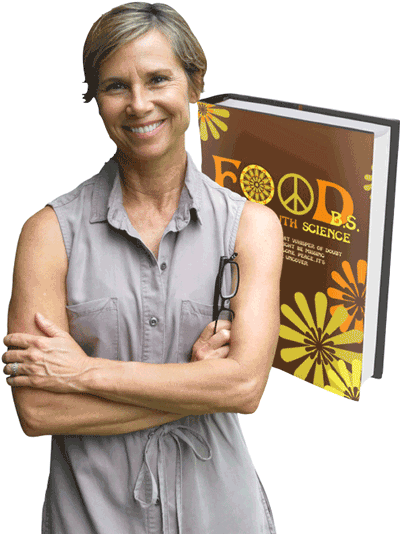
About Barbara McDermott
Regarded as America's #1 Insulin Suppression Coach, Barbara is the co-founder of SHIFT Health & Wellness Solution, and the best-selling author of the groundbreaking book, ‘FOOD B.S.’, With SHIFT, Barbara brings common sense to nutrition, weight loss and health gain. Her refreshing, no nonsense approach to uncovering the truth using non-negotiable rules of science demystifies food and how to defeat chronic disease once and for all.

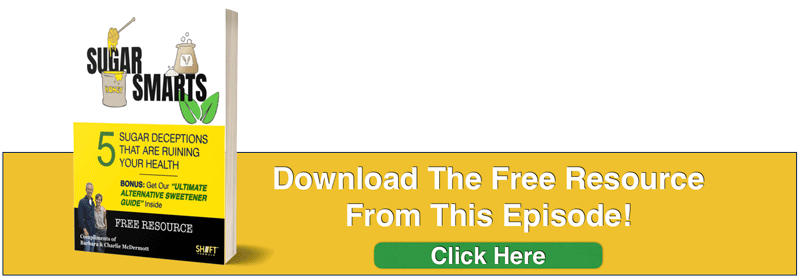
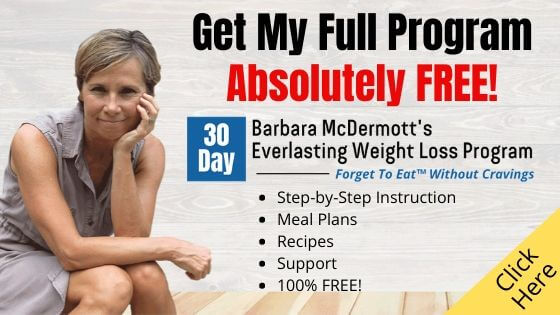

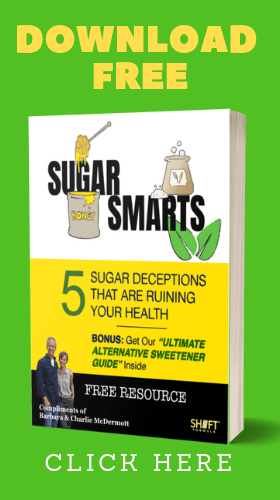
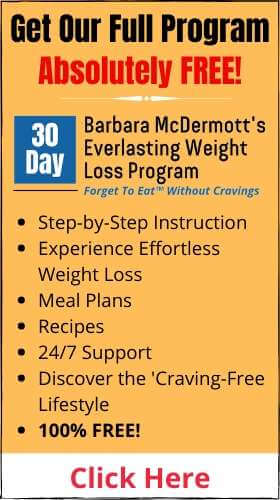
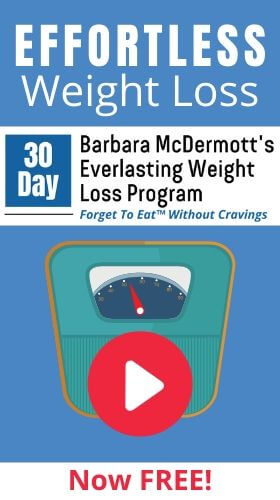
No comments yet.